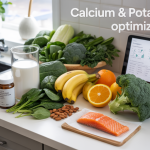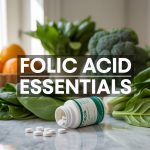Vitamin B3, also known as niacin, is a water-soluble vitamin that your body needs every single day to function properly. This essential nutrient plays a starring role in energy production, brain function, and keeping your skin healthy.
This guide is perfect for health-conscious individuals, fitness enthusiasts, and anyone curious about optimizing their nutrition through better vitamin intake. Whether you’re dealing with fatigue, skin issues, or just want to boost your overall wellness, understanding niacin can make a real difference.
We’ll explore the impressive health benefits that make vitamin B3 so important for your daily wellbeing. You’ll also learn how to spot the warning signs of niacin deficiency early, plus discover the best food sources and smart supplementation strategies to keep your levels where they need to be.
Understanding Vitamin B3 and Its Essential Role in Your Body
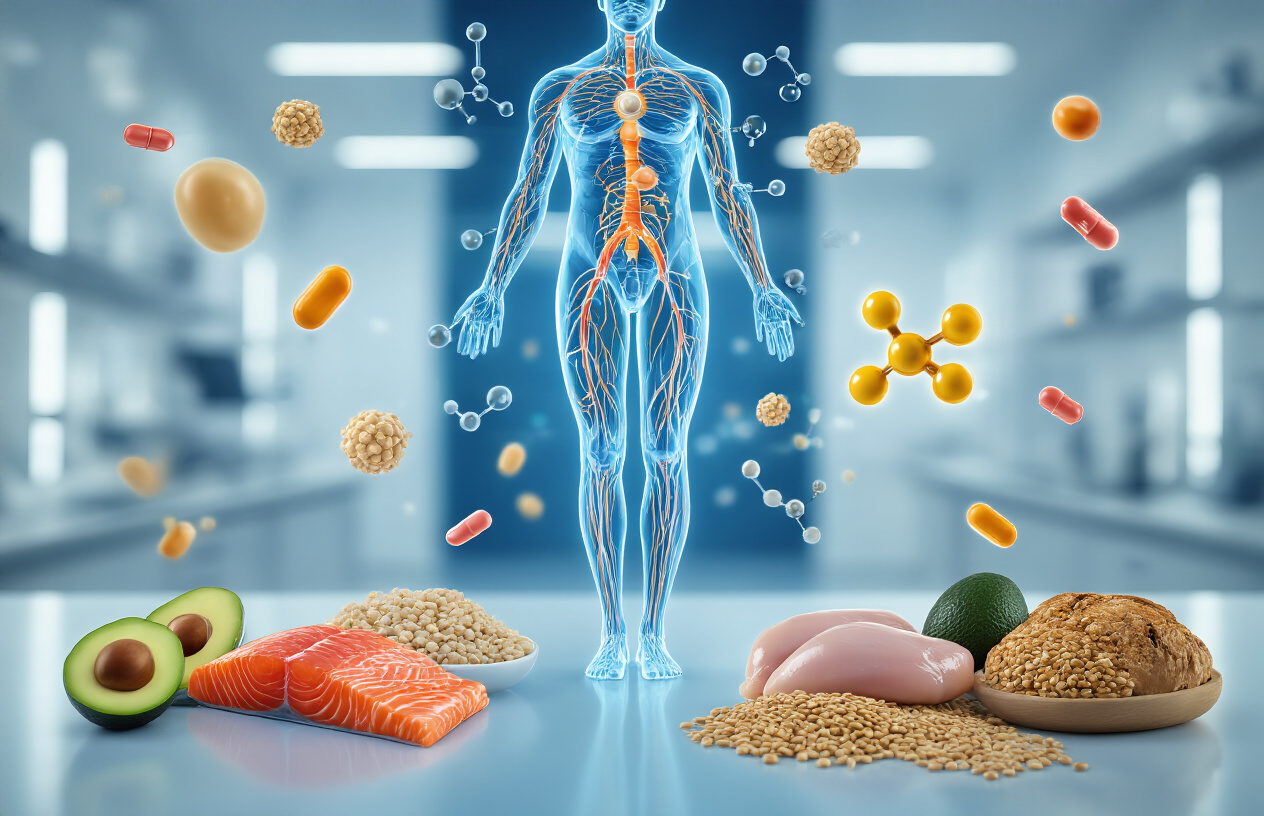
What Makes Niacin Different from Other B Vitamins
Niacin stands out among the B-vitamin family for several unique reasons. Unlike most other B vitamins that your body can only obtain through food or supplements, vitamin B3 has a special trick up its sleeve – your body can actually make small amounts of it from the amino acid tryptophan. Think of it as having a backup generator when the main power source runs low.
The conversion process is pretty fascinating but not very efficient. Your body needs about 60 milligrams of tryptophan to produce just 1 milligram of niacin. This means you can’t rely solely on tryptophan conversion to meet your daily needs, making dietary sources and supplements crucial for optimal health.
Another distinctive feature is niacin’s role as a precursor to two major coenzymes: NAD (nicotinamide adenine dinucleotide) and NADP (nicotinamide adenine dinucleotide phosphate). These coenzymes are involved in over 400 enzymatic reactions in your body – that’s more than any other vitamin-derived coenzyme. While other B vitamins support specific metabolic pathways, niacin’s influence spans across virtually every cellular process.
Niacin also has unique pharmacological properties at higher doses. While therapeutic doses of other B vitamins rarely cause dramatic effects, high-dose niacin can significantly lower cholesterol levels and cause the famous “niacin flush” – a harmless but noticeable skin reaction that doesn’t occur with other B vitamins.
How Your Body Uses Vitamin B3 for Optimal Function
Your body treats vitamin B3 like a master key that unlocks energy production at the cellular level. Once absorbed, niacin gets converted into those powerhouse coenzymes NAD and NADP, which become essential players in your metabolic machinery.
NAD primarily handles the energy-producing reactions in your cells. Every time you eat food, NAD helps break down carbohydrates, fats, and proteins to release usable energy. Picture NAD as a shuttle bus constantly picking up electrons from food molecules and delivering them to the cellular powerhouses called mitochondria. Without adequate NAD, this energy production system would grind to a halt.
NADP takes on a different but equally important role. This coenzyme focuses on biosynthetic reactions – the processes that build and repair cellular components. NADP helps create fatty acids for cell membranes, supports the production of cholesterol (yes, your body makes some cholesterol for essential functions), and assists in maintaining healthy DNA.
Your nervous system particularly depends on these niacin-derived coenzymes. Brain cells have enormous energy demands, and NAD ensures they get the fuel they need for optimal function. This is why niacin deficiency often shows up first as neurological symptoms like confusion or memory problems.
The coenzymes also support your body’s antioxidant defense system. They help regenerate other antioxidants like glutathione, creating a protective network that shields your cells from oxidative damage.
The Two Active Forms: Nicotinic Acid vs Nicotinamide
Vitamin B3 comes in two main forms that behave quite differently in your body, even though they both get converted into the same coenzymes. Understanding these differences can help you make better choices about supplementation and food sources.
Nicotinic acid, also called niacin, is the form that causes the characteristic “flush” reaction. When you take nicotinic acid supplements, especially on an empty stomach, you might experience temporary skin redness, warmth, and tingling. This happens because nicotinic acid triggers the release of prostaglandins, which dilate blood vessels near your skin surface. While this flush can be uncomfortable, it’s completely harmless and usually subsides within 30-60 minutes.
Nicotinamide (also called niacinamide) provides all the vitamin B3 benefits without the flush. Your body converts it to NAD and NADP just as efficiently as nicotinic acid, making it a popular choice for people who want to avoid the flushing reaction.
Here’s where things get interesting for therapeutic use:
| Aspect | Nicotinic Acid | Nicotinamide |
|---|---|---|
| Cholesterol Effects | Lowers LDL and raises HDL | No cholesterol effects |
| Skin Flush | Yes, especially at higher doses | No flush reaction |
| Absorption | Better with meals | Can be taken anytime |
| Cost | Generally less expensive | Usually more expensive |
For general nutrition and preventing deficiency, both forms work equally well. However, if you’re considering niacin for cholesterol management, only nicotinic acid provides cardiovascular benefits. The flush reaction actually correlates with the cholesterol-lowering effects, so the no-flush forms won’t help your lipid profile.
Food sources naturally contain both forms, with animal products typically providing more nicotinic acid and plant sources offering more nicotinamide.
Powerful Health Benefits That Transform Your Wellbeing

Boost Your Energy Levels and Combat Fatigue
Vitamin B3 plays a crucial role in converting the food you eat into usable energy. When your body has adequate niacin levels, your cells can efficiently process carbohydrates, fats, and proteins through the cellular powerhouses called mitochondria. This process directly impacts how energetic you feel throughout the day.
Many people experiencing chronic fatigue or afternoon energy crashes discover that their niacin levels are suboptimal. B3 helps maintain steady blood sugar levels by supporting proper glucose metabolism, preventing those dramatic energy spikes and drops that leave you reaching for another cup of coffee.
The vitamin also supports the production of NAD+ (nicotinamide adenine dinucleotide), a coenzyme essential for cellular energy production. As NAD+ levels decline with age, many people notice decreased energy and increased fatigue. Adequate B3 intake helps maintain these critical coenzyme levels.
Support Heart Health and Improve Cholesterol Levels
Niacin has been recognized for decades as one of the most effective nutrients for improving cardiovascular health markers. Regular B3 intake can significantly impact your cholesterol profile by raising HDL (good) cholesterol levels while lowering LDL (bad) cholesterol and triglycerides.
The mechanism works through niacin’s ability to reduce the liver’s production of VLDL cholesterol, which gets converted to LDL cholesterol in the bloodstream. Studies show that therapeutic doses of niacin can increase HDL cholesterol by 15-35% while reducing LDL cholesterol by 10-25%.
Beyond cholesterol management, B3 supports healthy blood vessel function by promoting vasodilation and reducing inflammation in arterial walls. This helps maintain healthy blood pressure and reduces the risk of atherosclerosis. The vitamin also supports proper circulation, ensuring oxygen and nutrients reach all parts of your body efficiently.
Enhance Brain Function and Mental Clarity
Your brain is one of the most metabolically active organs in your body, requiring consistent energy and proper blood flow to function optimally. Vitamin B3 supports both of these critical needs, making it essential for cognitive performance and mental clarity.
Niacin helps maintain healthy neurotransmitter production, particularly serotonin, which affects mood, sleep, and cognitive function. Many people report improved focus and mental sharpness when their B3 levels are adequate. The vitamin also supports the production of tryptophan, an amino acid precursor to serotonin.
Research suggests that adequate niacin intake may help protect against age-related cognitive decline and support memory formation. The vitamin’s role in maintaining healthy blood flow to the brain ensures that neural tissues receive the oxygen and nutrients needed for peak performance.
B3 also helps reduce brain fog and improve concentration by supporting stable blood sugar levels, preventing the mental fatigue that comes with glucose fluctuations.
Promote Healthy Skin and Slow Aging
Niacin offers remarkable benefits for skin health and appearance, working from the inside out to promote a youthful, radiant complexion. The vitamin supports healthy skin cell turnover, helping your body shed damaged cells and generate fresh, healthy ones more efficiently.
One of B3’s most notable effects is its ability to improve skin barrier function. A strong skin barrier retains moisture better and protects against environmental damage, pollution, and UV radiation. This leads to smoother, more hydrated skin with fewer signs of premature aging.
The vitamin also supports collagen production, the protein responsible for skin elasticity and firmness. As collagen levels naturally decline with age, adequate niacin intake helps maintain skin structure and reduces the appearance of fine lines and wrinkles.
Niacin’s anti-inflammatory properties help calm irritated skin and reduce redness, making it beneficial for those dealing with various skin conditions. The improved circulation from B3 intake also gives skin a healthy, natural glow by ensuring proper nutrient delivery to skin cells.
Strengthen Your Digestive System
Your digestive system relies heavily on B vitamins, including niacin, to function properly. Vitamin B3 supports the production of digestive enzymes and stomach acid, both essential for breaking down food and absorbing nutrients effectively.
The vitamin helps maintain the health of your intestinal lining, which serves as a barrier against harmful bacteria while allowing beneficial nutrients to pass through. A healthy gut lining is crucial for preventing digestive issues and supporting immune function, as roughly 70% of your immune system resides in your gut.
Niacin also supports the growth of beneficial gut bacteria, contributing to a balanced microbiome. This bacterial balance affects everything from nutrient absorption to mood regulation, as gut bacteria produce many neurotransmitters that influence mental health.
People with adequate B3 levels often experience better digestion, reduced bloating, and more regular bowel movements. The vitamin’s role in energy metabolism also ensures that digestive organs have the energy needed to perform their functions efficiently.
Identifying Vitamin B3 Deficiency Before It’s Too Late

Early Warning Signs Your Body Needs More Niacin
Your body has clever ways of signaling when it’s running low on vitamin B3, and paying attention to these early warnings can save you from more serious health problems down the road. The most noticeable signs often show up on your skin first – you might develop a red, scaly rash that looks like a sunburn, especially on areas exposed to sunlight like your face, neck, and hands.
Digestive issues frequently accompany niacin deficiency. You could experience persistent diarrhea, nausea, or vomiting that doesn’t seem connected to anything you’ve eaten. Your appetite might disappear entirely, making the problem worse as you eat even less of the nutrients your body desperately needs.
Mental and neurological symptoms can be particularly concerning. Brain fog, difficulty concentrating, and memory problems often develop gradually. You might feel unusually irritable, anxious, or depressed without any obvious reason. Some people report feeling dizzy or experiencing headaches that don’t respond well to typical remedies.
Physical fatigue that rest doesn’t cure is another red flag. Your muscles might feel weak, and you could develop a burning sensation in your hands and feet. Your tongue might become bright red, swollen, or unusually smooth – a condition doctors call “beef tongue” because of its distinctive appearance.
Sleep disturbances often accompany these symptoms, creating a cycle where poor sleep makes other symptoms worse while the deficiency makes quality sleep nearly impossible to achieve.
Risk Factors That Increase Your Deficiency Chances
Several lifestyle and health factors dramatically increase your chances of developing vitamin B3 deficiency. Alcohol dependence tops the list – excessive drinking interferes with niacin absorption and increases your body’s need for this crucial vitamin. People who consume alcohol regularly often have poor diets that lack adequate nutrition, compounding the problem.
Digestive disorders create significant absorption issues. If you have Crohn’s disease, ulcerative colitis, or other inflammatory bowel conditions, your intestines can’t effectively extract niacin from food. Similarly, people who’ve had gastric bypass surgery or other weight-loss procedures may struggle with nutrient absorption.
Certain medications can deplete your niacin levels. Isoniazid, used to treat tuberculosis, is particularly problematic. Some seizure medications and chemotherapy drugs also interfere with B3 metabolism. If you’re taking these medications long-term, your doctor should monitor your vitamin levels regularly.
Dietary restrictions put you at higher risk. Strict vegans who don’t eat fortified foods might struggle to get enough niacin, especially if they also avoid supplements. People with eating disorders or those following extremely restrictive diets often develop multiple nutrient deficiencies, including B3.
Geographic factors matter too. Populations that rely heavily on corn as a staple food face higher deficiency risks unless the corn is properly processed to release bound niacin. This historically affected many communities in the American South and parts of Africa and remains relevant in some areas today.
Long-term Health Consequences of Inadequate Intake
Chronic vitamin B3 deficiency leads to pellagra, a serious condition that can become life-threatening if left untreated. The classic “four Ds” of pellagra – dermatitis, diarrhea, dementia, and death – paint a grim picture of what happens when deficiency progresses unchecked.
The skin problems become severe and disfiguring. What starts as a simple rash evolves into thick, dark, scaly patches that can crack and bleed. These lesions typically appear symmetrically on both sides of the body and can leave permanent scarring even after treatment begins.
Neurological damage becomes increasingly serious over time. Mild confusion and memory problems progress to severe dementia, hallucinations, and psychotic episodes. The brain simply cannot function properly without adequate niacin to support cellular energy production and neurotransmitter synthesis.
Your digestive system suffers extensive damage. Chronic diarrhea leads to dangerous dehydration and electrolyte imbalances. The intestinal lining becomes inflamed and damaged, making it even harder to absorb nutrients from food. Weight loss becomes severe as your body struggles to maintain basic functions.
Cardiovascular health deteriorates as niacin deficiency affects cholesterol metabolism and blood vessel function. Your immune system weakens, leaving you vulnerable to infections that healthy individuals would easily fight off.
The sad reality is that severe pellagra, once common in parts of the United States, still occurs today in populations with limited access to diverse diets or in individuals with underlying health conditions that prevent proper nutrient absorption.
Smart Food Sources to Meet Your Daily Niacin Needs

Top Animal-Based Sources for Maximum Absorption
Animal products deliver vitamin B3 in its most bioavailable form, making them incredibly efficient sources for meeting your daily needs. Chicken breast stands out as a nutritional powerhouse, packing roughly 11.4 mg of niacin per 100 grams – that’s about 57% of your daily requirement in a single serving. The lean protein makes it a double win for your health goals.
Turkey follows closely behind, offering similar niacin levels while being versatile enough for sandwiches, salads, or hearty dinners. Fish lovers hit the jackpot with salmon, tuna, and sardines, which not only provide substantial niacin but also deliver heart-healthy omega-3 fatty acids. Canned tuna becomes particularly convenient, offering about 8.5 mg per 100 grams.
Beef liver takes the crown for niacin density, containing an impressive 17 mg per 100 grams. While organ meats might not appeal to everyone, they’re nutritional goldmines for those willing to include them. Even regular lean beef cuts provide solid amounts, typically ranging from 4-6 mg per serving.
Eggs deserve special mention for their convenience and versatility. Two large eggs contribute approximately 0.1 mg of niacin, and while this seems modest, eggs support the conversion of tryptophan to niacin, effectively boosting your overall levels.
Plant-Based Options for Vegetarians and Vegans
Plant-based eaters have plenty of excellent options to maintain optimal niacin levels. Mushrooms emerge as unexpected heroes, with portobello and crimini varieties providing substantial amounts. A cup of cooked portobello mushrooms delivers about 7 mg of niacin, making them perfect for hearty meals.
Nutritional yeast deserves recognition as a vegan superfood, packing an incredible 56 mg per quarter cup. This cheesy-tasting powder transforms ordinary dishes while dramatically boosting B-vitamin intake. Sprinkle it on popcorn, pasta, or salads for an instant nutritional upgrade.
Peanuts and peanut butter offer convenient snacking options with impressive niacin content. Two tablespoons of natural peanut butter provide roughly 4 mg, making your morning toast significantly more nutritious. Other nuts like almonds, sunflower seeds, and cashews contribute meaningful amounts while delivering healthy fats.
Green vegetables shouldn’t be overlooked. Avocados contain about 3.5 mg per medium fruit, while green peas offer approximately 3 mg per cup. Sweet potatoes provide around 1.7 mg along with beta-carotene and fiber.
Legumes like lentils, chickpeas, and black beans contribute modest but consistent amounts. A cup of cooked lentils provides about 2.1 mg, and when combined with other plant sources throughout the day, these amounts add up significantly.
Fortified Foods That Boost Your Intake Effortlessly
Food manufacturers have made meeting niacin requirements incredibly convenient through fortification programs. Enriched breakfast cereals often contain 100% of your daily niacin needs in a single serving, making morning nutrition virtually foolproof. Check labels carefully, as amounts vary widely between brands and types.
Fortified bread and grain products represent another effortless strategy. Most commercial breads, pasta, and rice products are enriched with B vitamins, including niacin. A single slice of enriched bread typically provides 1-2 mg, meaning your daily sandwich contributes meaningfully to your intake.
Instant oatmeal packets frequently contain added niacin, transforming your quick breakfast into a B-vitamin boost. Many varieties provide 25-50% of daily requirements, especially when combined with fortified milk alternatives.
Plant-based milk alternatives like soy, almond, and oat milk are increasingly fortified with B vitamins. These products make maintaining adequate niacin levels easier for vegans and those avoiding dairy. A cup of fortified soy milk can provide up to 3 mg of niacin.
Energy bars and meal replacement products often include comprehensive B-vitamin profiles. While these shouldn’t replace whole foods, they serve as convenient backup options during busy periods or travel.
| Food Category | Top Sources | Niacin Content (per 100g) |
|---|---|---|
| Poultry | Chicken breast, Turkey | 10-12 mg |
| Fish | Tuna, Salmon, Sardines | 8-11 mg |
| Organ Meats | Beef liver, Chicken liver | 15-17 mg |
| Mushrooms | Portobello, Shiitake | 6-7 mg |
| Nuts/Seeds | Peanuts, Sunflower seeds | 12-17 mg |
| Fortified Cereals | Various brands | 15-20 mg |
Supplementation Guidelines for Optimal Results
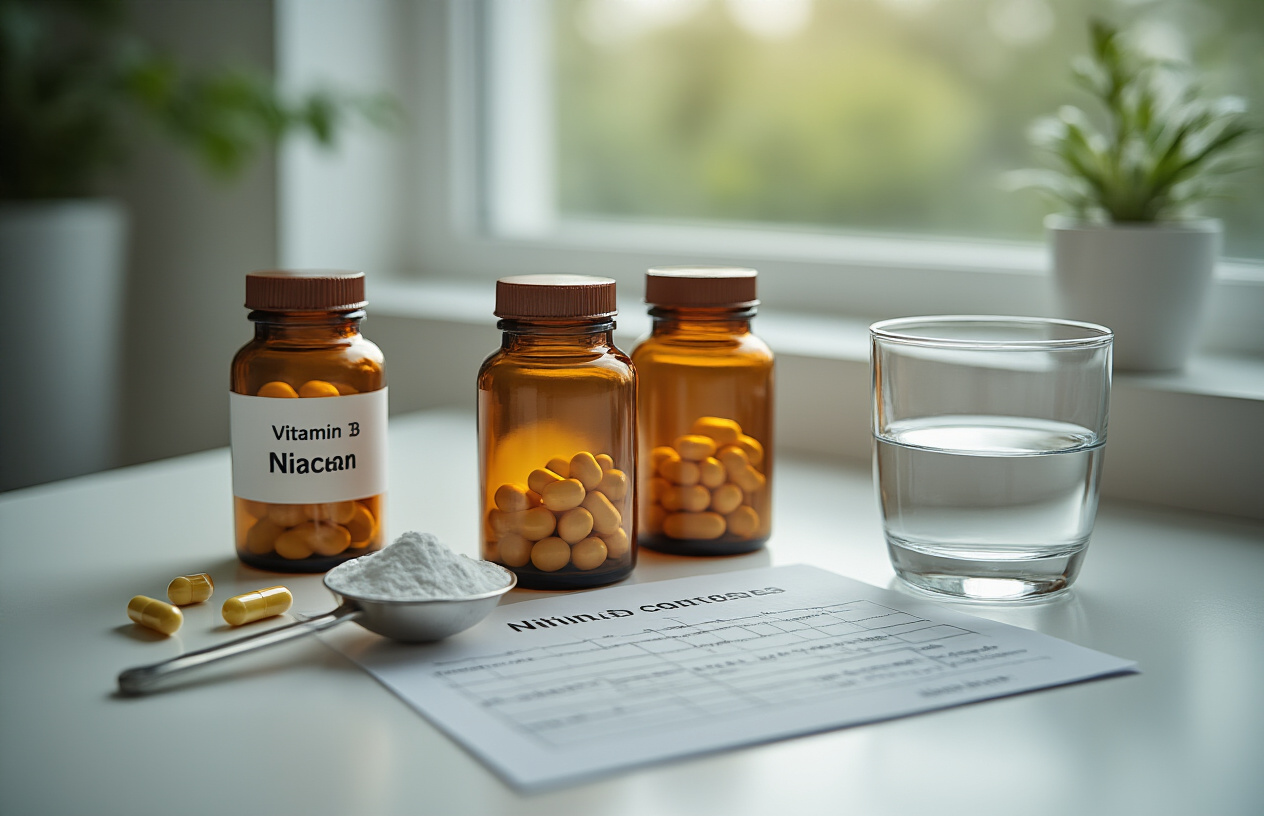
Determining Your Ideal Daily Dosage
Your niacin needs depend on several personal factors, including your age, gender, activity level, and specific health goals. The recommended dietary allowance (RDA) serves as your baseline: adult men need 16 mg daily, while adult women require 14 mg. Pregnant women should aim for 18 mg, and breastfeeding mothers need 17 mg daily.
If you’re dealing with specific health concerns, your dosage requirements might be significantly higher. For cardiovascular support, therapeutic doses typically range from 500-2,000 mg daily, but this should only be done under medical supervision. Athletes and highly active individuals may benefit from slightly elevated doses due to increased metabolic demands.
Start with lower doses and gradually increase to assess your tolerance. Your body’s response to niacin varies based on your current nutritional status, liver function, and individual metabolism. People with existing deficiencies often notice improvements with doses closer to the RDA, while those seeking therapeutic benefits may need higher amounts.
Choosing Between Different Supplement Forms
Niacin supplements come in three main forms, each with distinct characteristics and applications. Immediate-release niacin (nicotinic acid) is the most potent form for raising HDL cholesterol and improving lipid profiles, but it commonly causes the “niacin flush” – a temporary reddening and warming sensation.
Extended-release niacin reduces flush symptoms by releasing the vitamin slowly over several hours. This form maintains therapeutic benefits while minimizing uncomfortable side effects, making it popular for long-term cardiovascular support. However, extended-release formulations carry a slightly higher risk of liver complications with prolonged use.
Niacinamide (nicotinamide) provides the metabolic benefits of niacin without causing flush symptoms or significantly impacting cholesterol levels. This form works excellently for general health maintenance, skin conditions, and supporting cellular energy production.
| Form | Flush Effect | Cholesterol Benefits | Best For |
|---|---|---|---|
| Immediate-release | High | Maximum | Cholesterol management |
| Extended-release | Low | Good | Long-term therapy |
| Niacinamide | None | Minimal | General health |
Timing Your Intake for Maximum Effectiveness
Taking niacin with food significantly reduces stomach irritation and improves absorption. Your body processes niacin more efficiently when it’s combined with other nutrients, particularly when taken alongside a balanced meal containing healthy fats.
For immediate-release niacin, split larger doses throughout the day to minimize side effects and maintain steady blood levels. Take your first dose with breakfast, and if you’re using higher therapeutic doses, add a second dose with dinner. This approach helps your body adjust gradually to the vitamin’s effects.
Extended-release formulations work best when taken once daily with your largest meal, typically dinner. The slow-release mechanism ensures steady vitamin levels throughout the night when your body performs many repair and regeneration processes.
Avoid taking niacin with hot beverages or alcohol, as these can intensify flush reactions. Cold water or room-temperature drinks work best. If you’re using niacin for sleep support (due to its tryptophan-preserving effects), take it 2-3 hours before bedtime.
Managing the Niacin Flush Effect Safely
The niacin flush is a harmless but sometimes uncomfortable reaction that occurs 15-30 minutes after taking immediate-release niacin. Your skin may become red, warm, and tingly, particularly on your face, neck, and chest. This reaction happens because niacin causes blood vessels to dilate, improving circulation.
Reduce flush intensity by taking an aspirin 30 minutes before your niacin dose. The aspirin blocks prostaglandin production, which is responsible for the flush response. Start with 81 mg (baby aspirin) to test your response before using a full 325 mg dose.
Gradually increase your niacin dosage over 2-3 weeks to build tolerance. Begin with 100 mg daily and increase by 100 mg every few days until you reach your target dose. This method allows your body to adapt and significantly reduces flush severity over time.
Stay hydrated and avoid hot showers, saunas, or intense exercise immediately after taking niacin, as these activities can intensify the flush reaction. If you experience severe or prolonged flushing, reduce your dose and consult with a healthcare provider about switching to an extended-release form or niacinamide.
Potential Side Effects and Safety Considerations

Common Reactions and How to Minimize Them
The most notorious side effect of vitamin B3 supplementation is the “niacin flush” – a temporary but intense skin reaction that catches many people off guard. Your face, neck, and sometimes your entire body can turn bright red, accompanied by a burning, tingling sensation that lasts anywhere from 15 minutes to an hour. This happens because niacin causes blood vessels to dilate rapidly, increasing blood flow to your skin.
While the flush looks alarming, it’s completely harmless and actually indicates the supplement is working. To minimize this reaction, start with smaller doses (around 50-100mg) and gradually increase over several weeks. Taking niacin with food or after a meal significantly reduces flush intensity. Some people find that taking an aspirin 30 minutes before their niacin dose helps prevent the reaction.
Other common side effects include stomach upset, nausea, and diarrhea, especially when taking higher doses on an empty stomach. These digestive issues usually resolve by taking supplements with meals and staying well-hydrated throughout the day.
Extended-release niacin formulations can reduce flushing but may increase the risk of liver problems at high doses. If you experience persistent nausea, yellowing of skin or eyes, or unusual fatigue, stop taking the supplement immediately and consult your healthcare provider.
Drug Interactions You Should Know About
Niacin can significantly amplify the effects of blood pressure medications, potentially causing dangerously low blood pressure. If you’re taking ACE inhibitors, beta-blockers, or calcium channel blockers, monitor your blood pressure closely when starting niacin supplements. Your doctor may need to adjust your medication dosages.
Blood-thinning medications like warfarin can become more potent when combined with high-dose niacin, increasing bleeding risk. Regular blood work becomes even more critical if you’re on anticoagulants and considering niacin supplementation.
Diabetes medications present another area of concern. Niacin can raise blood sugar levels, potentially counteracting the effects of insulin or oral diabetes drugs. People with diabetes should work closely with their healthcare team to monitor blood glucose levels and adjust medications as needed.
Statin cholesterol medications combined with niacin create a double-edged situation. While this combination can be highly effective for managing cholesterol, it significantly increases the risk of muscle problems, including the serious condition called rhabdomyolysis. Regular monitoring of muscle enzymes through blood tests becomes essential.
Alcohol consumption while taking niacin supplements can worsen flushing reactions and increase the risk of liver damage, particularly with sustained-release formulations.
Special Precautions for Specific Health Conditions
People with liver disease should approach niacin supplementation with extreme caution. High doses can worsen existing liver problems or cause liver damage in susceptible individuals. Those with a history of hepatitis, cirrhosis, or elevated liver enzymes should avoid niacin supplements unless specifically prescribed and monitored by a physician.
Active peptic ulcers or a history of stomach problems make niacin supplementation risky, as it can increase stomach acid production and worsen ulcers. The flushing reaction can also be more severe and uncomfortable for people with sensitive digestive systems.
Gout sufferers need special consideration because niacin can raise uric acid levels, potentially triggering painful gout attacks. If you have a history of gout, discuss alternative approaches with your doctor before starting niacin supplements.
Gallbladder disease patients should be aware that niacin might worsen their condition or interfere with gallbladder function. The supplement can affect bile production and flow, which could complicate existing gallbladder issues.
Pregnant and breastfeeding women should stick to dietary sources of niacin rather than supplements, as high doses could potentially harm the developing baby. The recommended dietary allowance during pregnancy is easily achievable through food sources alone.
People with kidney disease may need dose adjustments, as their bodies process and eliminate niacin differently than healthy individuals. Regular kidney function monitoring becomes important when using niacin supplements in this population.
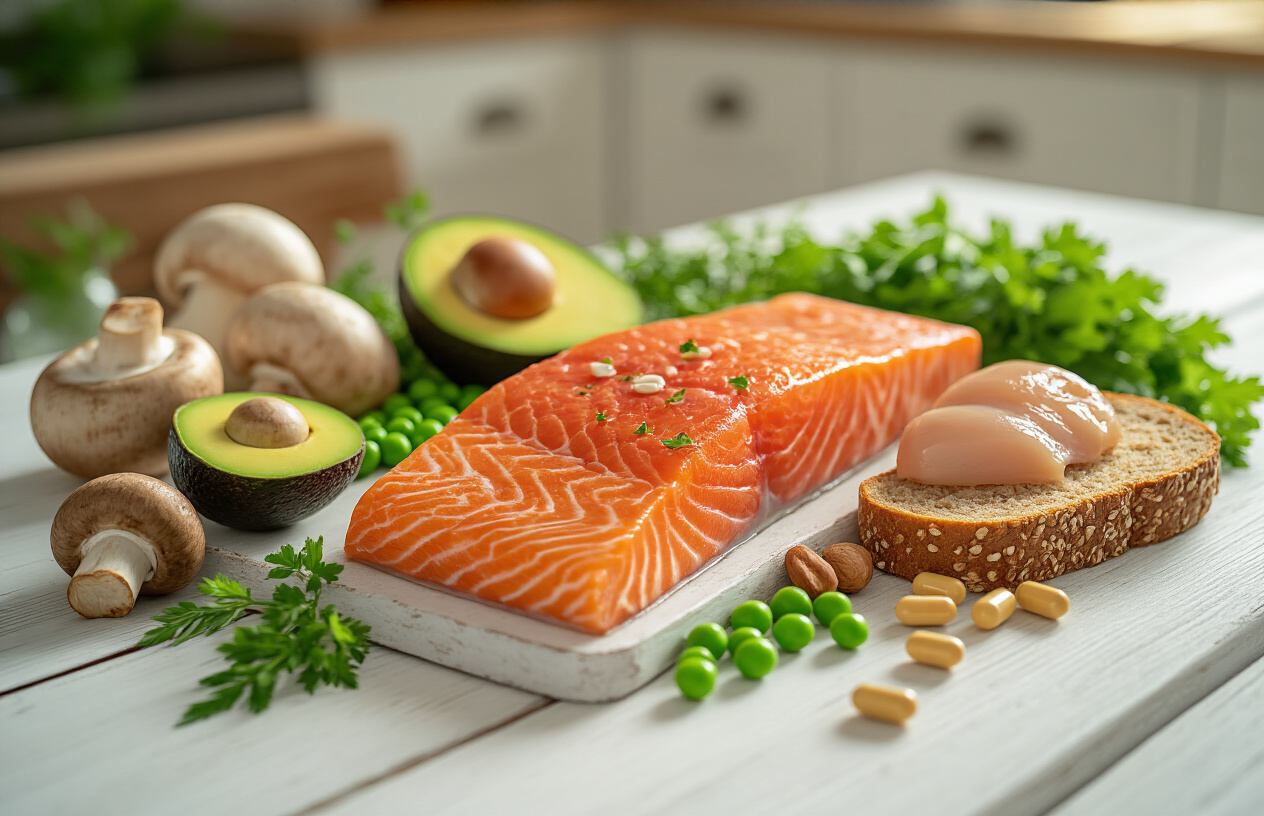
Vitamin B3 stands out as one of the most crucial nutrients your body needs to function at its best. From boosting energy metabolism and supporting brain health to maintaining healthy skin and cholesterol levels, niacin plays a vital role in countless bodily processes. Recognizing deficiency symptoms early and addressing them through smart dietary choices can prevent serious health complications down the road.
The good news is that meeting your daily niacin requirements doesn’t have to be complicated. Focus on including protein-rich foods like chicken, fish, and legumes in your meals, along with whole grains and leafy greens. If you’re considering supplements, start with lower doses and consult your healthcare provider to find the right approach for your specific needs. Remember that balance is key – while B3 deficiency can cause problems, too much can also lead to unwanted side effects. Take charge of your health by making niacin-rich foods a regular part of your diet and monitoring how your body responds.


